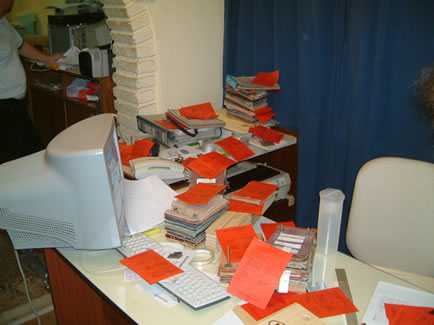We propose a test. Below are a series of questions. If you answer yes to more than 5, then you are ready to implement. 5S in his office.
| Ask | But | |
| 1 | People struggle to find pens, paper, folders, keys, etc.? | |
| 2 | Are there things such as folders, documents, equipment that have no apparent owner? | |
| 3 | Do you or your colleagues accumulate pens, paper clips, old magazines in drawers? | |
| 4 | Are there any unused papers or phone books gathering dust? | |
| 5 | Are there safety elements such as fire extinguishers lying around that have already expired? | |
| 6 | Are there any loose and/or visible cables? | |
| 7 | Are there old, unlabeled, or torn folders? | |
| 8 | Is it difficult for visitors and/or clients to find the right person and/or desk? | |
| 9 | Are the trash cans full? | |
| 10 | Are there times when work elements are missing? | |
| 11 | Is valuable space taken up by unwanted or unused items? | |
| 12 | Is there general disorder in your office or workplace? | |
| 13 | Are there documents, folders, papers, brochures, etc. mixed together? | |
| 14 | Is there dust, dirt, cobwebs in nooks and crannies? |
So the 5S
Implementing them in offices has concrete benefits:
- Create organized workplaces.
- Radically improves document search time.
- Create a sense of belonging.
- Improves productivity and efficiency.
- Reduce customer response times
- Helps identify and eliminate losses.
Some basic clues
1st SEIRI: Separate what is necessary from what is unnecessary (including documents, files, plans, reports, office supplies, etc.)
To begin separating, we must establish clear criteria. For example: Has this document been used in the past month?
An exercise to facilitate the activity is to differentiate between necessary items (all those required for the effective functioning of the workplace, in the appropriate quantities) and desired items (for example, 20 pens in a pencil holder, many of which no longer work, another 20 in the desk drawer, old documents stored with the idea that one day we will use them again).
Statistics show that the amount of discarded documentation corresponds to approximately half of the generated documentation!!
Campaigns should aim to minimize the amount of documents and materials kept on hand.
2nd SEITON: A place for everything/data and everything/data in its place
5 keys can be useful to us at this stage:
- Eliminate wasted time searching for information and/or office supplies (pens, staplers, etc.)
- Facilitate access to everyday items
- Facilitate the return of things to their usual place
- Store/identify so that anyone can quickly see it
- Avoid private “collections.”
It's also a time to reorganize the office layout and set challenging criteria. For example: if it takes us more than 30 seconds to find a document, then we need to keep improving!
3ªS SEISO: Cleaning is inspection
It involves maintaining the methodology through daily actions. For example, running an antivirus on your computer, reviewing and separating incomplete, expiring, or overdue documents, etc.
4th SEIKETSU: Standardized cleaning
The time has come to fix:
- Policies for document retention, inventory management, disposal
- Procedures for storage, labeling, storage locations
- Rules such as: turning off your computer before leaving, spending 5 minutes a day organizing your physical and computerized files, etc.
5th SHITSUKE: Discipline
This last step speaks to the habit of transforming the 5S into part of the work routine. To achieve this: train everyone in the methodology (make sure new employees are onboarded immediately!); ensure best practices are shared; conduct audits; and repeatedly communicate the goals and benefits.
Example 1to S in office

And now? Let's start over. Implementation is a spiral cycle, where each new step allows us to go deeper and continue improving.
